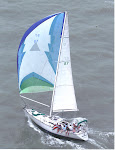Happy after a successful install!
This post may turn out to
be boring and technical, but it does start with a real episode from
2010 in Long Island, Bahamas. White Pepper
had spent 3 lovely days at Thompson's Bay, Long Island and was headed
north. Thompson's Bay is not too far away, but it is over the edge
of the datasphere. It was a lovely day with blue skies and gentle
breezes. However, without a weather forecast I was miserable with
anxiety. I was sure that any minute now a black cloud would appear
on the horizon to blast us down. I spent most of the afternoon in
the cabin trying to coax an inadequate radio into giving us a
forecast over an unreliable and horribly static filled frequency. I
began to consider what would make me happy.
Up
until then we had been limping along with Internet where it was
available and VHF updates from local “nets” or fellow cruisers.
Clearly an upgrade was needed if we were to become more independent.
The time honored solution for cruisers is SSB, single side band. SSB
is expensive, difficult to install and maintain, and craps out in bad
weather—just when you need it.
My
thought was to use a satellite phone to obtain the weather. Compared
to SSB satellite telephony is cheap(er), easier to install, and
available anytime—especially the military grade Iridium phones.
When the time came to pull the trigger I was talked into the
Globalstar system. These satellites fly lower than the Iridium's and
require a ground based antenna so they are not truly world wide. But
they do work well in the Bahamas, Gulf of Mexico, and US East Coast
which is White Pepper's
cruising grounds. If I ever do go to Europe an upgrade will be
needed. Globalstar is also about half price compared to Iridium at
the present time.
I
ordered a sat phone, antenna, docking station, wi-fi hot spot, and
1000 minutes all for under $2000. Jan called it a Christmas present.
My plan was to use OCENS weather. I had used them previously with
the Internet. I had found their system of gathering data and
presenting it to be quite satisfactory. All of the weather data is
actually free provided to the public by NOAA in grib files. However,
getting this data into the boat and onto the computer in a coherent
form is quite difficult. I was happy to pay OCENS literally pennies
per page to do that task for me.
All
of the stuff arrived at Vero Beach City Marina. The first sentence
in the skimpy instruction manual was that “This installation
should be done by a professional.” They were right. After three
days of hand to hand combat in the nav station and several calls to
OCENS, it was all done. The Globalstar sat phone had 4 bars and the
Optimizer hot spot had three lights across. I made a few clicks on
the computer, pushed the GO button, and about one second later a 7
day forecast appeared on the screen. I can't tell you how delighted
and amazed I was. Indeed, I took the whole rest of the day off and
went to lunch and the beach with Jan.
My
hope is now that the weather will be instantly available to White
Pepper no matter how remote the
location, how late the hour, or how bad the atmospheric conditions.
Also satellite phones provide emergency communications and e-mail.
Satellite phone can not provide the camaraderie of the SSB nets, say
the Cruiseheimer's net, but I will fore go that for now.
Saw this remarkable face drawn in the sand just before high tide (click on it to see the full face)




.JPG)
.JPG)

.JPG)








